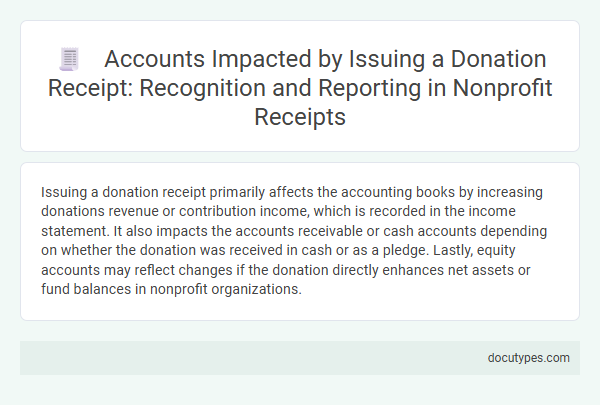Issuing a donation receipt primarily affects the accounting books by increasing donations revenue or contribution income, which is recorded in the income statement. It also impacts the accounts receivable or cash accounts depending on whether the donation was received in cash or as a pledge. Lastly, equity accounts may reflect changes if the donation directly enhances net assets or fund balances in nonprofit organizations.
Overview of Donation Receipt Issuance
Issuing a donation receipt primarily affects charitable contribution accounts and donation revenue accounts. These accounts record the value and acknowledgment of the donated funds or assets.
Your organization's accounts receivable and tax-related accounts may also be impacted when a donation receipt is issued. Proper documentation ensures accurate financial reporting and compliance with tax regulations.
Key Accounts Impacted by Donation Receipts
Issuing a donation receipt directly affects specific financial accounts that reflect the transaction accurately in accounting records. Understanding the key accounts impacted by donation receipts is essential for proper financial management and compliance.
- Donation Revenue Account - Records the value of donations received, increasing the organization's income.
- Accounts Receivable - May be adjusted if donations are pledged but not yet received, reflecting outstanding donor commitments.
- Cash or Bank Account - Shows the inflow of actual funds when a donation is collected and the receipt is issued.
Revenue Recognition for Contributions
| Account Affected | Impact Description |
|---|---|
| Contribution Revenue | Increases as donations are recognized upon issuing the receipt, reflecting earned income from contributions. |
| Accounts Receivable (if applicable) | Decreases when the donation is received and receipt issued, marking collection of pledged amounts. |
| Cash or Bank | Increases when the physical or electronic donation payment is processed, confirming receipt of funds. |
| Deferred Revenue (if conditional) | Decreases when conditions related to the donation are met, allowing revenue recognition and receipt issuance. |
| Net Assets | Increases reflecting the overall growth in organization's equity from recognized contributions. |
When you issue a donation receipt, proper revenue recognition ensures your financial statements accurately reflect received contributions and related accounts. Correctly identifying which accounts are impacted promotes transparency and compliance with accounting standards.
Recording Donations: Assets and Liabilities
Issuing a donation receipt impacts specific accounts within an organization's financial records. Your accurate recording ensures clear tracking of assets received and related liabilities.
- Asset Accounts - Donations received increase cash or accounts receivable, reflecting an inflow of resources to the organization.
- Liability Accounts - If the donation is conditional, a deferred revenue or liability account records the obligation until conditions are met.
- Revenue Recognition - Upon satisfying donation conditions, liabilities decrease as revenue is recognized in the income statement.
Donor Acknowledgment and Receipting Requirements
Issuing a donation receipt primarily affects the donor's and the organization's accounts. The donor uses the receipt to claim tax deductions, while the organization records the receipt as proof of the contribution.
Donor acknowledgment is crucial for transparency and compliance, ensuring the donor receives official recognition of their gift. Receipting requirements typically mandate detailed information, including the donor's name, donation amount, date, and a statement confirming no goods or services were provided in exchange. Proper documentation supports accurate financial reporting and tax filing for both parties.
Impact on Fund Balances and Net Assets
Issuing a donation receipt directly affects the fund balances by increasing the revenue accounts associated with contributions. This increase in revenue subsequently enhances net assets, reflecting the organization's improved financial position. Accurate recording ensures compliance with accounting standards and transparent reporting to donors and stakeholders.
Reporting Contributions in Financial Statements
Issuing a donation receipt impacts several key accounts within your financial statements by accurately reflecting contributions received and ensuring compliance with reporting standards. Proper recording of these transactions affects how your organization reports revenue and donor activity.
- Contribution Revenue - Donation receipts increase recorded contribution revenue, reflecting the inflow of donated resources.
- Accounts Receivable - When pledges are made but not yet received, donation receipts may adjust accounts receivable balances.
- Net Assets - Contributions reported via donation receipts affect unrestricted or restricted net assets depending on donor stipulations.
Recording donation receipts precisely ensures transparent and accurate reporting of your organization's financial position.
Compliance with Accounting Standards for Donations
Issuing a donation receipt primarily affects the donor's accounts, specifically their expense or contribution accounts, and the recipient organization's revenue accounts. Accurate recording ensures transparency and compliance with accounting standards related to charitable contributions.
Compliance with accounting standards mandates that donation receipts reflect the true value and nature of the donation, influencing financial statements and tax reporting. Both parties must carefully document and report the transactions to maintain regulatory adherence and audit readiness.
Internal Controls Over Donation Receipts
Issuing a donation receipt primarily affects the Donations Revenue account and the Cash or Bank account, reflecting the inflow of donated funds. Proper internal controls ensure accurate recording and timely issuance of receipts, maintaining donor trust and compliance with tax regulations. Regular reconciliation and authorization processes help prevent errors and potential fraud in donation receipt management.
Which Accounts Are Affected by Issuing a Donation Receipt? Infographic

